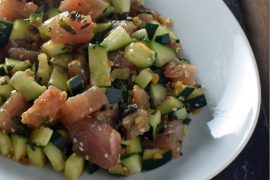 |
|
Source: Arzak
|
As part of our journey through the Basque Country, we had the pleasure of visiting the world renowned Restaurante Arzak, a three-Michelin starred restaurant in San Sebastian. Run by the legendary Juan Mari Arzak and his daughter Elena, it consistently ranks as one of the best restaurants in the world. Arzak is at the forefront of la Nueva Cocina Vasca, the New Basque Cuisine that has influenced chefs all over the world, including back home in New York. This is the third installment of our three-part feature on the Arzaks and their restaurant.
 |
| Chocolates and other goodies in the Arzak workshop. |
Having just finished our meal at Arzak we were elated and, to be fair, a little bit drunk. Our waiter led us back into the lounge where we had been invited to have coffee with Juan Mari and Elena Arzak. He sat us down next to a silver tray of chocolates made into the shapes of keys, nuts, and bolts, and labeled with the words “Ferreteria Arzak” – Arzak’s workshop.
Juan Mari and Elena emerged from the door opposite the dining room where our tour of the kitchen had begun a few hours earlier. Our coffees arrived and Elena summoned herself a glass of cava. Then they sat down opposite us on the couch, and together they began to tell us their story.
The Restaurant
 |
| Elena and Juan Mari in their restaurant kitchen (source: Arzak). |
The restaurant was founded by Juan Mari’s grandparents in 1897 to be a wine cellar and tavern in the village of Alza, which later became part of San Sebastian. When Juan Mari’s parents took over, they turned it into a restaurant serving traditional Basque Food; old favorites that are still served today, like hake in green sauce, squid in its ink, and the local fish soup (which I enjoyed a few days earlier in Hondarribia). As a child, Juan Mari learned to cook at his mother’s side. He still credits her as his most important teacher.
“Some people ask us why we do not move to a fancier setting or a more prestigious location,” Elena interjected. “That would be impossible,” she said, “there are so many things here that I remember from my childhood.” Juan Mari nodded, looking at his daughter proudly. “This is a family restaurant,” he added.
Elena, for her part, began working in the restaurant during summer vacation at the age of 11, when her grandmother was still the head chef. When she was old enough, her father sent her abroad to work at several of Europe’s top restaurants, finally returning to Spain to work at the renowned El Bulli. Today she is co-head chef with her father at the family restaurant. In 2012, she was named best female chef in the world in the survey organized by Restaurant Magazine.
The two seem thrilled to work side-by-side in the kitchen. “Elena and I are a tandem,” Juan Mari explained. “No dish is served in the restaurant unless we are both in agreement.”
Experimentation and Invention of New Basque Cuisine
 |
| Cromlech with caramelized onion and foie gras |
Even as a young man, Juan Mari wanted to go beyond the traditional dishes his mother was cooking. She happily let him experiment, giving him a small section of the kitchen to use. In 1974 the restaurant received its first Michelin star.
Two years later, in 1976, something very important happened. The “Club de Gourmets” magazine organized a mesa redonda–a “round table” discussion in Madrid attended by well regarded Spanish and French chefs, including 34-year-old Juan Mari.
(At this point in the story, Juan Mari leaned forward on the couch and became very focused; I could tell he considered this part very significant and needed me to understand.)
At the mesa redonda, the great French chef Paul Bocuse was talking about nouvelle cuisine; the New French Cuisine. This was extremely exciting to Juan Mari, and also to his lifelong friend Pedro Subijana, whose own restaurant Akelaŕe also went on to receive three Michelin stars. After the mesa redonda, the two of them—Arzak and Subijana—went off to France to learn more about this “new cuisine”.
Then they went home and started working on something really big. They were going to create a style of cooking the world had never seen before: la nueva cocina vasca—the New Basque Cuisine.
Inventing an entirely new cuisine required a lot of thought, study, and experimentation. They had to consider the history and tradition of the Basque people as well as its future.
“Were you trying to reinvent your mother’s old classics?”, I asked. “No,” Juan Mari said firmly, wagging his finger at me. “We are always looking forward; never backward.”
 |
| Juan Mari Arzak (source: Arzak) |
I struggled to understand this at first. Was the idea to bring global cooking back to Basque Country, I asked, thinking of all the worldly ingredients we found upstairs in the pantry opposite the test kitchen. “No,” he said just as firmly, wagging his finger back and forth again. Were you applying the French or international ideas you learned at the mesa redonda? “No.” He kept wagging his finger.
Then he explained: Arzak and Subijana took from the round table discussion simply the idea that a chef could study his roots and cause the gastronomic culture and cuisine to evolve, never losing sight of his tradition. The project was—and still is—entirely forward-looking, experimental, and centered in the culture and character of the region. The idea was not to modernize traditional dishes, or to incorporate worldly influences. It was to create the Basque cuisine of the future.
The Characteristics of New Basque Cuisine
 |
| Monkfish at low tide (source: Arzak) |
So what makes it Basque?
I may not be competent to answer that question, but I can tell you what I observed about the food at Arzak. First, the food is centered on local ingredients; not all of the ingredients in each dish, but the principal ones—the fish, the meat, the corn. It is prepared with great respect for the bounty of the region.
“We always use parsley in our dishes,” Elena had told to me as I enjoyed crispy “cromlech” filled with foie gras and caramelized onions. “The Chinese use ginger. We use parsley because it is from this region.” The parsley was pulverized into a fine dust, but it retained its flavor and also its place on the Basque table.
Many basic ingredients incorporated in the elaborate dishes could be found on typical Spanish and Basque menus—chorizo, melon, eggs, mussels, blood sausage—integrated with exotic ingredients from around the world without depriving them of their essential character. Ham was conspicuously absent.
Perhaps most importantly, there is something much more intangible, more philosophical, about Juan Mari and Elena’s cooking. The spirit of the cuisine is Basque. “This food could not be made anywhere else,” Juan Mari insisted. Perhaps it was his convincing and passionate demeanor (or perhaps it was the wine), but sitting there I believed it was true.
The Draw of San Sebastian as a Culinary Mecca
 |
| Elena preparing Arzak’s famous “cromlech and onion with tea and coffee” (source: Arzak). |
As I learned quickly and thoroughly during my time there, San Sebastian is a magnet for top-notch food and innovative cuisine. It has more Michelin stars (sixteen total) per square meter than any other city in the world, including three of Spain’s five three-Michelin star restaurants (Arzak, Akelaŕe and Berasategui). It also boasts two of the top ten restaurants in the world (Arzak and Mugaritz), according to the yearly survey. You can have a top-flight meal just wandering down the street. So I had to ask them: why here? Why San Sebastian?
“We don’t know,” they replied, shrugging, perhaps a little too quickly.
 |
| Arzak’s wine cellar (source: Arzak) |
I can hazard some guesses. San Sebastian sits at a crossroads of Spanish and French cuisine, nestled on a porous border made even more porous by the common Basque identity on both sides. Its coastal location and grassy, hilly terrain yield an abundance of fresh seafood, meats, and other key ingredients. There is money in the area to spend on good food, as the Basque country is one of Spain’s wealthier regions and its nice beaches for years have provided it an influx of foreign cash and vacationers looking for great meals.
There is a cultural emphasis on great food, too.
“There is very little socio-economic disparity in San Sebastian,” Elena explained, “it’s almost entirely middle class.” And the middle-class population makes great food a priority. “People save their money to come here,” Juan Mari added. “Ordinary people. Some people come once every month or two if they have the money; others once a year.”
It also matters, of course, that San Sebastian is where Juan Mari Arzak and Pedro Subijana chose to do their work. Their innovation on the New Basque Cuisine has attracted other creative chefs who want to tap into that creative spirit and, of course, to learn from the great masters themselves.
On New York’s Food Scene
 |
| The chefs test sauces in their restaurant kitchen. |
Many of those up-and-coming chefs can be found in the city’s casual pintxos bars, dishing out intricate small plates to diners standing at the bar. I observed that in New York, too, many top chefs have turned away from the high-end restaurant in favor of more casual establishments, like Battersby, Marc Forgione, and Momofuku (to name just a few out of many), where chefs turn out fine dining fare in casual and, at times, hectic settings. I wondered why.
“It takes so much money to start a restaurant,” Elena said. “We are lucky. We inherited this place.” Most talented chefs don’t have the luxury to inherit a space like that or the money to invest in it, she explained, so when they strike out on their own they turn to casual joints where they can show their stuff without the need for crystal chandeliers. Customers benefit because it reduces the price of fine dining and expands its accessibility to a greater number of people.
I was unsurprised to learn that Elena and Juan Mari were quite familiar with New York’s food scene and thought highly of it, rattling off numerous restaurants in the Big Apple in which they had had memorable meals. Their sous chef Igor Zalakain had volunteered to me earlier during our tour of the restaurant that he thought “what is happening in New York is very important” and that he had traveled there with Elena and Juan Mari to sample the food. Elena agreed. “What is important is the result,” she said. “Everyone gets there in different ways.”
On Warmth
 |
| Triangles of prickly pear with thin red chili threads |
The New York Times’s Pete Wells recently complained, rightly in my view, that too many high-end restaurants in New York have lost sight of the fact that their job is to please the customer, and that their job is not simply to produce great food and put it down in front of their patrons to eat.
I have had too many meals lately where the food was great, but the restaurant made me feel like I should consider myself lucky to be graced with a chance to eat there, and not in a good way. There have been bizarre reservation systems, hours-long waits for a table, attitude about food preferences, weird rules, an absent head chef. No warmth.
At Arzak, there is no such arrogance. As intellectual as their food is, the Arzaks and their staff display great appreciation for the chance to please the you, the customer; to delight you with superlative food and a warm atmosphere. The restaurant demonstrates that you can wow your customers with a parade of spectacular courses while at the same time making them feel like you have welcomed them into your home.
“Either Elena or I has to be in the restaurant every day,” Juan Mari told me, explaining that when they must travel together they simply close the restaurant. As we talked and enjoyed our coffee, father and daughter would get up periodically to exchange kisses with regular customers who had come to enjoy their yearly meal.
I could not help but notice that Elena’s children—Juan Mari’s grandchildren—had been having dinner in the next room when we arrived. Elena’s husband designed the kitchen. During dinner, Juan Mari and Elena regularly roamed the dining room, patting shoulders, sniffing wine, and chatting up their guests.
“This is the kind of restaurant that I want to have,” said Juan Mari. “We give you a little bit of our heart.”
 |
| Juan Mari and Elena with a happy customer, my wife. |
Restaurante Arzak
Av del Alcalde José Elosegi, 273
20017 Donostia-San Sebastián, Guipúzcoa, Gipuzkoa, Spain
+34 943 27 84 65
www.arzak.info




Bravo!! Muy bien escrito, David. Que bonita las fotos! El cuento del restaurante y la familia es muy bien explicado y me siento como si puedo entender de una manera mas profunda la atmosfera y la historia detras del restaurante y de esta familia. Gracias a ti entiendo exactamente que lo hace un restaurante tan especial y unico.
Gracias, Amanda! Simplemente fue fenomenal tener la oportunidad de comer alli.
Regards from Basque Country
Nueva York visita The Basque Country: Pintxos, Costa Vasca, Ezpeleta, entrevista a los Arzak y dos recetas
http://bit.ly/16W1n66
Gracias, AboutBC! Como habéis escrito en vuestro artículo, es cierto que lo hemos pasado muy bien (y hemos comido muy bien) en vuestra tierra.